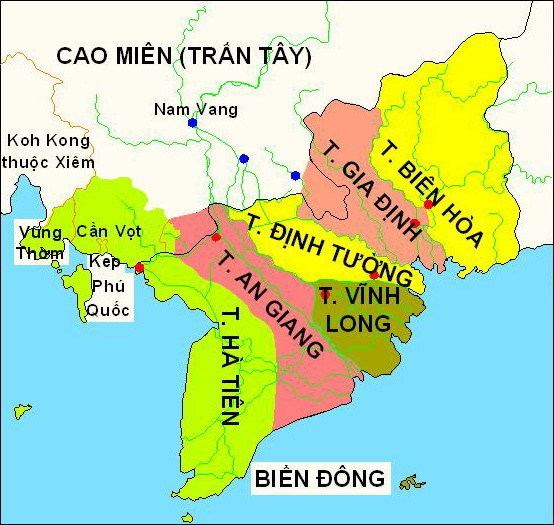 | ||
The Six Provinces of Southern Vietnam (Vietnamese: Nam Kỳ Lục tỉnh, 南圻六省 or just Lục tỉnh, 六省) is the historical name for a particular region of Southern Vietnam which is referred to in French as Basse-Cochinchine. (Lower Cochinchina). The region was politically defined and established after the independence of the Nguyễn Dynasty, and lasted from 1832, when Emperor Minh Mạng introduced administrative reforms, to 1867, which culminated in the eight-year French campaign to conquer the Six Provinces.
Contents
- History
- French division into 21 smaller provinces discontinuation of the Six Provinces
- Administrative divisions
- References
The six provinces, which in 1832 Emperor Minh Mạng divided Southern Vietnam into, are:
These provinces are often subdivided into two groups: the three eastern provinces of Gia Định, Định Tường, and Biên Hòa; and the three western provinces of Vĩnh Long, An Giang, and Hà Tiên.
History
The Mekong Delta region (the location of the Six Provinces) was gradually annexed by Vietnam from the Khmer Empire starting in the mid 17th century to the early 19th century, through their Nam tiến territorial expansion campaign. In 1832, Emperor Minh Mạng divided Southern Vietnam into the six provinces Nam Kỳ Lục tỉnh.
According to the Đại Nam nhất thống chí (Nguyễn Dynasty national atlas) of the Quốc sử quán (official Nguyễn-era compilation of Vietnamese history, geography and people from 1821-1945), in 1698 the lord Nguyễn Phúc Chu established the prefecture (phủ) of Gia Định. In 1802, emperor Gia Long turned Gia Định prefecture into a township, and in 1808, he renamed Gia Định prefecture into a governorate containing the 5 townships of Phiên An, Biên Hòa (or Đồng Nai), Định Tường, Vĩnh Thanh (or Vĩnh Long), and Hà Tiên. In 1832, emperor Minh Mạng renamed Phiên An Citadel into Gia Định Citadel, and the 5 townships were turned into the 6 provinces of Phiên An, Biên Hòa, Định Tường, Vĩnh Long, Hà Tiên, and the newly established An Giang. Thus, the Six Provinces was created in 1832; and in 1834 the Six Provinces were collectively called Nam Kỳ ("Southern Region", which would eventually be known in the West as Cochinchina). Phiên An Province was renamed to Gia Định Province in 1835.
After the French colonial invaders, led by vice-admiral Rigault de Genouilly attacked and captured the three eastern provinces of Gia Định, Định Tường, and Biên Hòa in 1862, and invaded the remaining western provinces of Vĩnh Long, An Giang, Hà Tiên in 1867, the French Empire abolished the administrative divisions created by the Nguyễn Dynasty. At first, the French used départements instead of prefectures, and arrondissements in place of districts (huyện). By 1868, the former Nam Kỳ Lục tỉnh had over 20 arrondissements (districts). Cochinchina was ruled by a French government-appointed governor in Saigon, and each county had a Secrétaire d’Arrondissement (en: "County Secretary", vi: "thư ký địa hạt" or "bang biện"). Bạc Liêu county was created in 1882. On 16 January 1899, the counties were changed into provinces per a French government decree, each with a provincial premier (fr: "chef de la province", vi: "chủ tỉnh") who is head of provincial government.
French division into 21 smaller provinces, discontinuation of the Six Provinces
The French government divided the original Six Provinces into 21 smaller ones. Following the 1899 decrees, starting 01/01/1900 Nam Kỳ would be divided into the following 21 provinces:
The reason why Southern Vietnam was divided into 21 provinces was because the French Empire intended to erase the name "Lục tỉnh" from the hearts and minds of the Vietnamese people and language, and cut any feelings of attachment and Vietnamese nationalism with this region, in attempts to avert potential local revolution or rebellion that may arise. In 1908 on the newspaper Lục Tỉnh Tân Văn ("Six Provinces News"), lead editor by Gilbert Trần Chánh Chiếu, still commonly used the names "Lục Tỉnh" and "Lục Châu". Along with the French Empire calling Southern Vietnam (vi: Nam Kỳ) as Cochinchine, they called Northern Vietnam (vi: Bắc Kỳ) as Tonkin, Central Vietnam (vi: Trung Kỳ) as Annam. "Cochinchina" is the name used by Westerners.
Administrative divisions
Sources for entire table:
